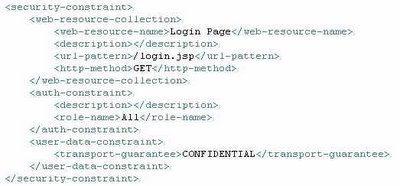J2EE based web application can use container provided features to protect only certain pages of the application with SSL and leave the rest unencrypted. This is done by placing a security constraint (in the web deployment descriptor) on the specific page (login.jsp) and add a user-data-constraint to it. The user-data-constraint element contains a single required child element transport-guarantee. Assigning a value of CONFIDENTIAL to this element will enable secure transport for the selected resource. The following table shows the security constraint definition in the web deployment descriptor.


Hi,
ReplyDeleteThe only problem is when other resources are protected and the login.jsp form is invoked, the URL does not changed to login.jsp, but remains with the original resource we need to protect.
Therefore no SLL is enforced on the login page, since the URL never changes to login.jsp.
Do you have any solution?